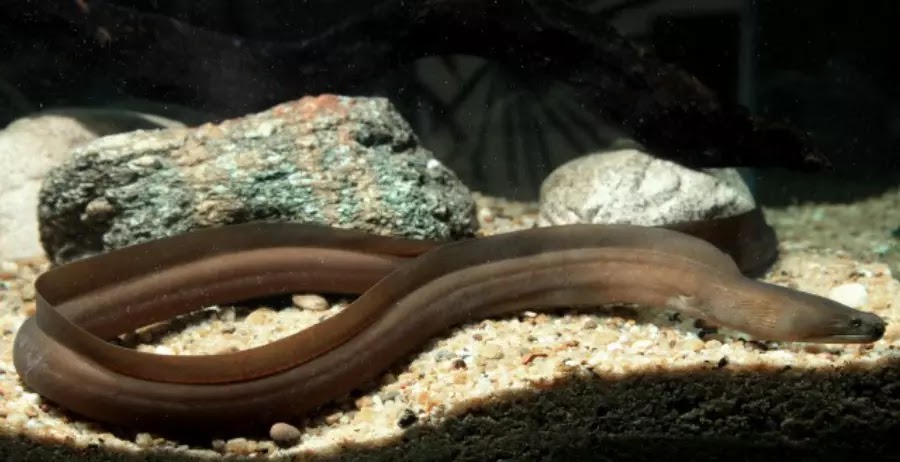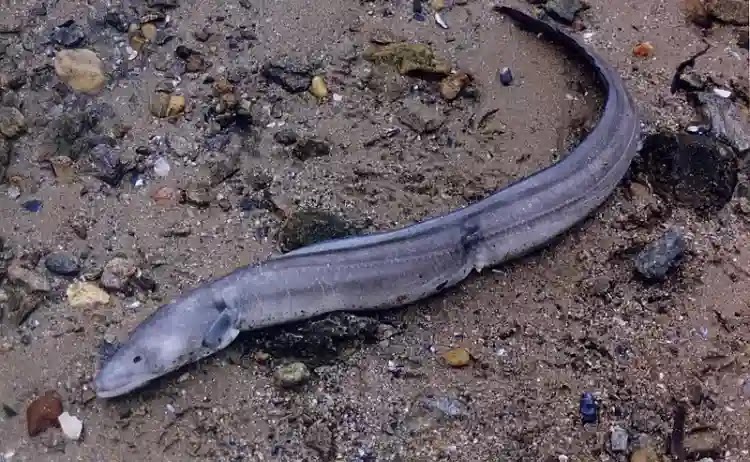Largest
Top 10 Biggest Eels In The World
Eels, enigmatic and ancient creatures that inhabit both freshwater and saltwater environments, have captured the curiosity of humans for centuries. With their sinuous bodies and fascinating life cycles, eels stand as one of the most mysterious denizens of aquatic ecosystems.
These remarkable creatures are found in various parts of the world, often shrouded in myth and folklore. From their extraordinary migrations spanning thousands of miles to their unique ability to adapt to diverse habitats, eels have long intrigued scientists and storytellers alike.
ADVERT
Here we would like to share the top 10 biggest eels in the world based on their overall length and their respective backgrounds.
10. American Eel (~1.5 Meters)
The American Eel, scientifically known as Anguilla rostrata, is a fascinating aquatic species found in the freshwater and estuarine environments of North America. These eels are known for their elongated, snake-like bodies, which can grow to impressive lengths.
While the average size of an American Eel typically ranges from 2 to 3 feet (approximately 60 to 90 centimeters), some individuals have been documented reaching lengths of up to 5 feet (about 1.5 meters) or even longer.
In terms of weight, they can weigh several pounds, with larger specimens tipping the scales at over 5 pounds (around 2.3 kilograms). As opportunistic predators, they play a crucial part in the food web by feeding on a diverse diet that includes fish, insects, crustaceans, and various aquatic organisms.
9. California Moray Eel (~1.5 Meters)
 |
| Credit: Wikimedia Commons |
The California Moray Eel, scientifically known as Gymnothorax mordax, is a captivating marine creature known for its impressive size and striking appearance. This eel species inhabits the coastal waters of the eastern Pacific Ocean, particularly along the coastlines of California and Baja California.
California Moray Eels can grow quite large, with individuals commonly reaching lengths of up to 5 feet (approximately 1.5 meters) or more. Their elongated, serpentine bodies are typically a rich brown or olive color, adorned with striking patterns of darker spots or blotches.
Despite their formidable size, California Moray Eels are generally reclusive and nocturnal creatures. They spend their days hidden within crevices and rocky shelters, only venturing to hunt for prey at night.
8. Southern Conger (~2 Meters)
 |
| Credit: Wikimedia Commons |
The Southern Conger, scientifically known as Conger cinereus, is a species of eel renowned for its impressive size and remarkable presence in the world's oceans. These formidable creatures are found predominantly in the temperate and subtropical waters of the southern hemisphere, particularly off the coasts of Australia and New Zealand.
Unlike many other eel species, which tend to be relatively small, Southern Congers can grow to astounding lengths, often reaching well over six feet (approximately 2 meters) and weighing more than 60 pounds (about 27 kilograms). These measurements make them one of the largest eel species in the world.
ADVERT
Their elongated, snake-like bodies, which are usually grayish-brown in color, help them blend into their underwater environments. Southern Congers are carnivorous and feed on a diet primarily consisting of fish, cephalopods, and crustaceans.
7. Fangtooth Moray Eel (~2.4 Meters)
The Fangtooth Moray Eel, scientifically known as Enchelycore anatina, is a truly remarkable and intimidating marine creature. These eels are found in the warm, tropical waters of the Atlantic Ocean, particularly in regions such as the Caribbean Sea and the Gulf of Mexico.
These eels typically reach lengths of 4 to 5 feet (approximately 1.2 to 1.5 meters), although some individuals have been known to exceed 8 feet (about 2.4 meters). Their elongated bodies are covered in smooth, scaleless skin and are primarily brown or gray in color, with a striking pattern of darker blotches and speckles.
One of the most distinctive features of the Fangtooth Moray Eel is its fearsome set of teeth, which are exceptionally sharp and menacing. These eels have a mouth full of long, needle-like teeth that can deliver a powerful bite when hunting prey.
6. Green Moray Eel (~2.4 Meters)
The Green Moray Eel, scientifically known as Gymnothorax funebris, is a captivating marine species celebrated for its striking emerald-green coloration and its huge size. This eel species is found in the warm, tropical waters of the western Atlantic Ocean, particularly in regions such as the Caribbean Sea, the Gulf of Mexico, and parts of the Atlantic coast of South America.
These eels typically grow to lengths of 6 to 8 feet (approximately 1.8 to 2.4 meters) and can reach even greater sizes in some cases. Their bodies are long, slender, and serpent-like, with vibrant green skin that can appear almost fluorescent underwater.
However, Green Moray Eels are generally non-aggressive toward humans and are known for their reclusive nature. They tend to spend their days hidden within rocky crevices, coral formations, or shipwrecks on the ocean floor.
5. American Conger (~3 Meters)
 |
| Credit: Wikimedia Commons |
The American Conger, scientifically known as Conger oceanicus, is a remarkable and iconic marine species that is present in the cold waters of the North Atlantic Ocean. American Congers are typically found in deep-sea environments, often residing in cold, dark waters at depths ranging from 600 to 1,200 feet (approximately 180 to 370 meters) or even deeper.
American Congers are known for their impressive size, with mature individuals commonly reaching lengths of 6 to 7 feet (approximately 1.8 to 2.1 meters) and occasionally exceeding 10 feet (about 3 meters) or more.
ADVERT
Their bodies are elongated, serpentine, and usually grayish or brownish in color, helping them blend seamlessly into their underwater habitats. One of the most distinctive features of the American Conger is its voracious appetite. These eels are opportunistic predators that feed on a diverse diet.
4. Slender Giant Moray (~3.7 Meters)
 |
| Credit: Wikimedia Commons |
The Slender Giant Moray, scientifically known as Strophidon sathete, is a truly remarkable and awe-inspiring marine creature. This species is found primarily in the warm, tropical waters of the Indian Ocean, including the coasts of the Indian subcontinent and Southeast Asia.
Mature individuals typically range from 6 to 9 feet in length (about 1.8 to 2.7 meters) but have been known to reach lengths of up to 12 feet (approximately 3.7 meters) or more. Their bodies are elongated, cylindrical, and usually gray or brown in color, adorned with intricate patterns and speckles.
One of the most remarkable features of the Slender Giant Moray is its formidable set of teeth, which are large, sharp, and arranged in multiple rows. These teeth are designed for capturing and holding onto prey.
3. European Conger (~3.7 Meters)
The European Conger, scientifically known as Conger conger is one of the biggest eel species in the world and is commonly found in the cold waters of the eastern Atlantic Ocean, including the Mediterranean Sea.
The European Conger is notable for its gigantic size, with adults regularly reaching lengths of 6 to 10 feet (approximately 1.8 to 3 meters). However, they can occasionally grow even larger, with some individuals reported to exceed 12 feet (about 3.7 meters) in length.
Their bodies lack scales, and while their typical coloration is gray, they can also exhibit a blackish hue. Although sightings generally take place at depths ranging from 0 to 1,500 feet beneath the ocean surface, they can venture to depths as profound as 10,000 feet when migrating to their spawning grounds.
2. Grey Conger (~4 Meters)
 |
| Credit: Wikimedia Commons |
The Grey Conger, scientifically known as Conger esculentus, is a remarkable species of eel that is celebrated for its impressive size and presence in the depths of the North Atlantic Ocean.
Grey Congers are among the largest eels in the world, with individuals commonly reaching lengths of up to 10 feet (approximately 3 meters) and occasionally even exceeding 13 feet (around 4 meters). These eels are characterized by their long, serpentine bodies and a distinctive gray or brownish-gray coloration.
ADVERT
Their powerful jaws and sharp teeth enable them to capture and consume a wide range of prey, making them significant contributors to the ecosystem dynamics in their deep-sea habitats. These eels are known to dwell in deep-sea environments, often found at depths of 300 feet (around 90 meters) or more.
1. Giant Moray Eel (~4 Meters)
The Giant Moray Eel, scientifically known as Gymnothorax javanicus is generally found in the warm, tropical waters of the Indo-Pacific region, including the Red Sea, the Indian Ocean, and the western and central Pacific Ocean.
These eels are known to be the largest eel in the world with mature individuals commonly reaching lengths of 8 to 10 feet (approximately 2.4 to 3 meters). Some exceptional individuals have been documented exceeding 13 feet (about 4 meters) in length, making them truly gigantic in the world of eels.
The Giant Moray Eel boasts an elongated, snake-like body, which is typically colored in various shades of brown, black, or gray, sometimes with patterns or speckles. They have sharp teeth and powerful jaws, which they use to capture prey.
Also read: Top 5 Largest Tuna Species In The World














Post a Comment
0 Comments